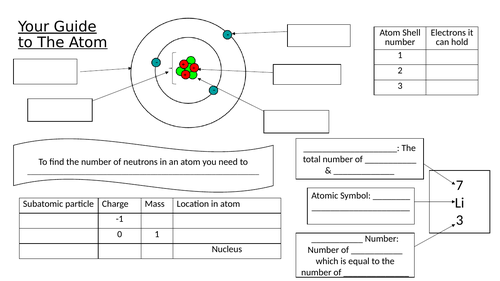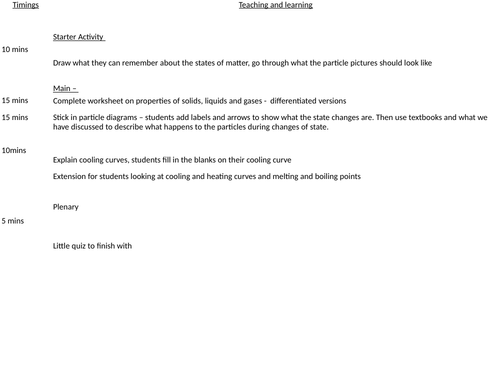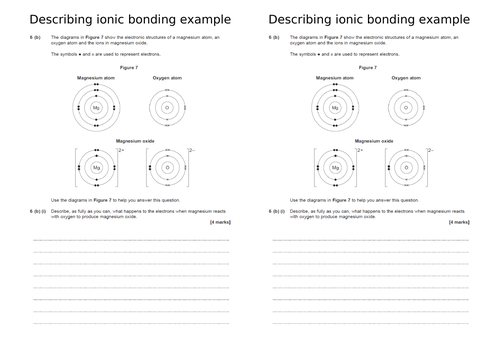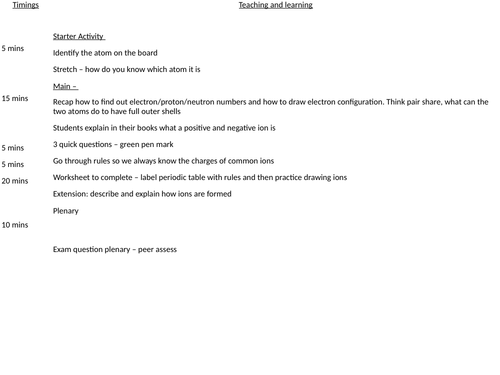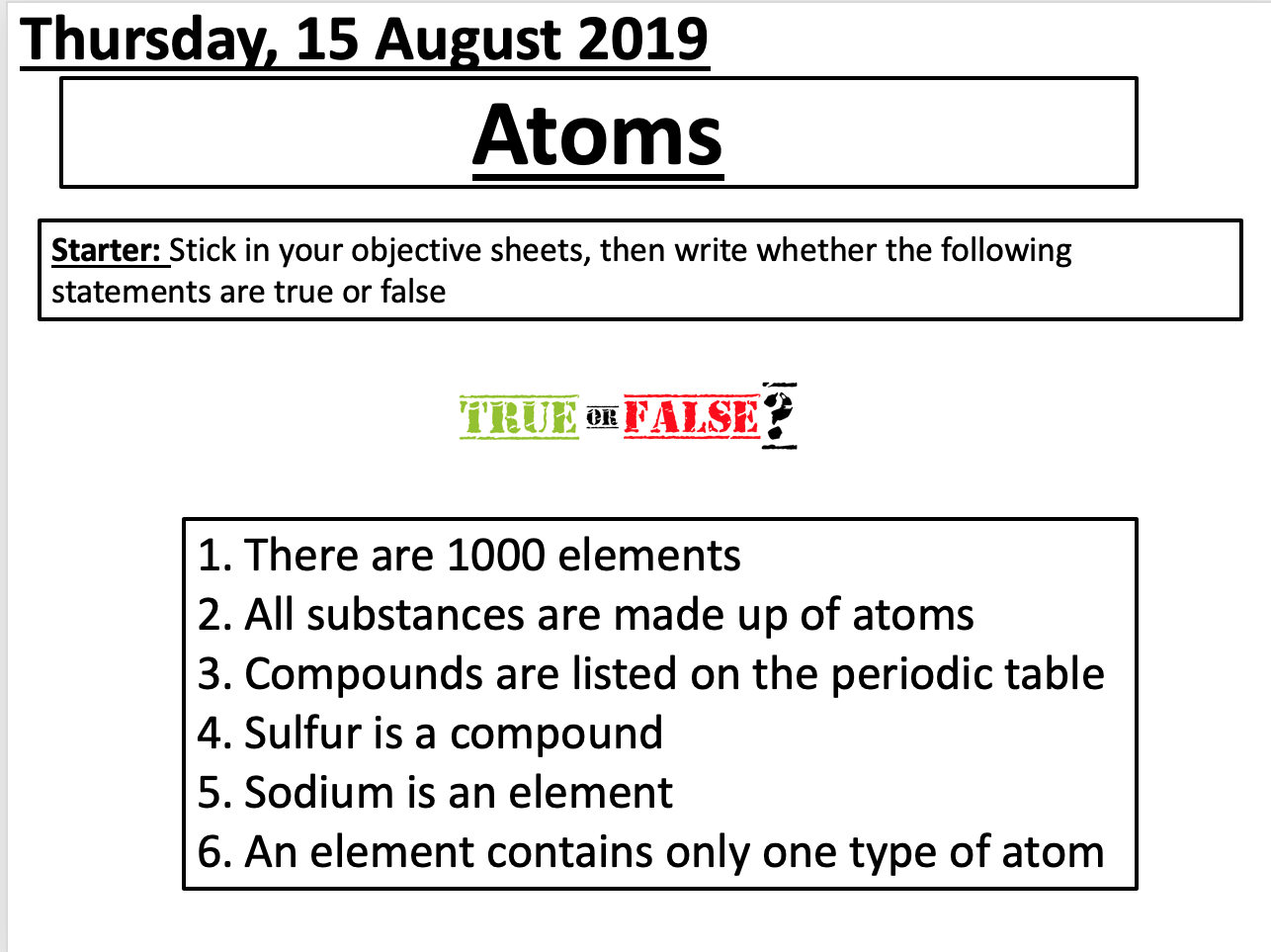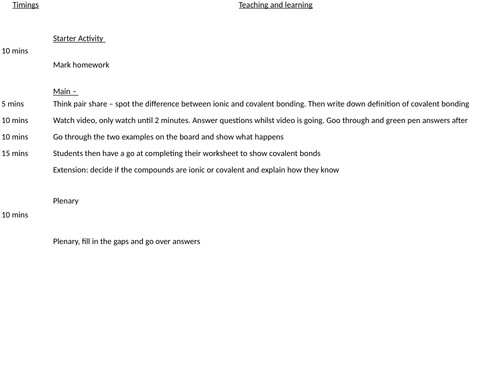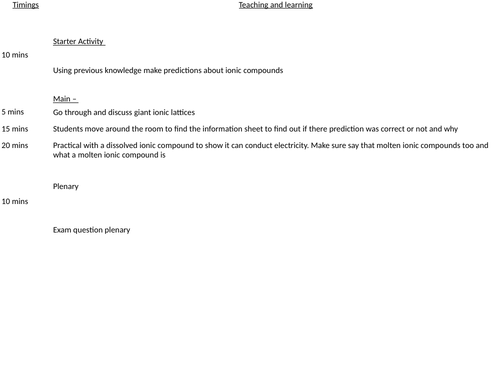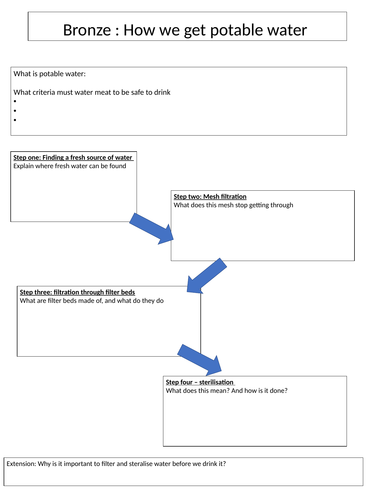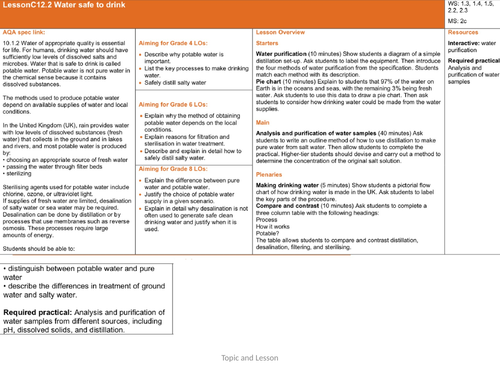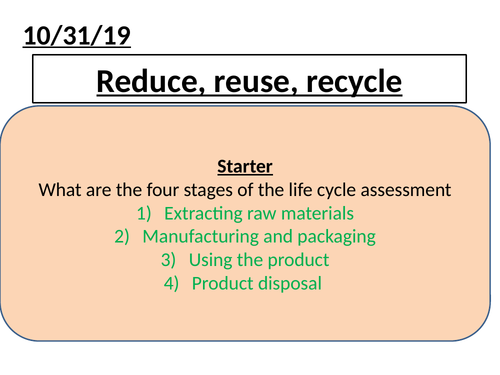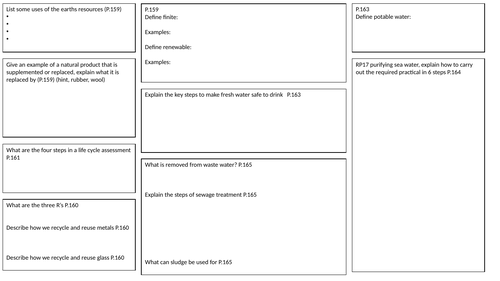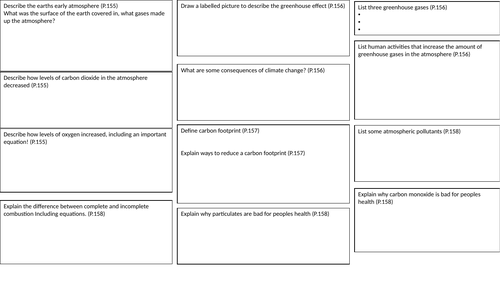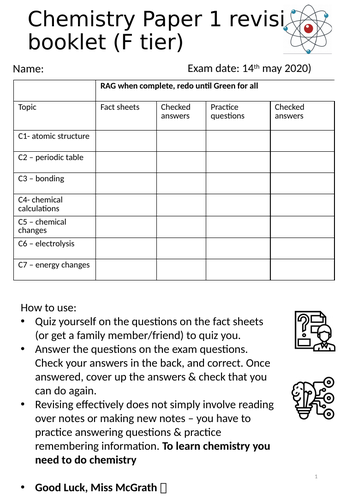
124Uploads
37k+Views
9k+Downloads
Chemistry

C1.6 structure of the atom
aimed at a mixed ability year 9 class
Starter Activity
Put atom structures in the correct order thinking back to last lesson
Main –
Work through work sheet in steps. To ensure maximum understanding
Chase the element – race task to find out what each element around the room is, identifying proton neutron and electron number and matching it with an element on the periodic table
Make a model of an atom using string, and card (cut card into circles use string to attach them together)
Plenary
Tweet what you’ve learnt tday

C3.1 States of matter - Foundation
Aimed at a foundation class
Starter Activity
Draw what they can remember about the states of matter, go through what the particle pictures should look like
Main –
Complete worksheet on properties of solids, liquids and gases - differentiated versions
Stick in particle diagrams – students add labels and arrows to show what the state changes are. Then use textbooks and what we have discussed to describe what happens to the particles during changes of state.
Explain cooling curves, students fill in the blanks on their cooling curve
Extension for students looking at cooling and heating curves and melting and boiling points
Plenary
Little quiz to finish with

C3.3 Ionic bonding - foundation
Aimed at a lower ability class
Starter Activity
Ions recap, what charge do elements have in different groups
Stretch question to think about how group 1 and 2 will interact with group 6 and 7
Main –
Go through the video and answer the questions, go through answers
Practice drawing ionic compounds Extension: explain the difference between KBr and K2O
Go through the answers which are on the slides
Exam question practice to move onto if have a chance
Plenary
4 mark exam question – peer assess
Good to show the detail they need in their answers

C3.2 atoms into ions - Foundation
aimed at a lower ability class
Starter Activity
Identify the atom on the board
Stretch – how do you know which atom it is
Main –
Recap how to find out electron/proton/neutron numbers and how to draw electron configuration. Think pair share, what can the two atoms do to have full outer shells
Students explain in their books what a positive and negative ion is
3 quick questions – green pen mark
Go through rules so we always know the charges of common ions
Worksheet to complete – label periodic table with rules and then practice drawing ions
Extension: describe and explain how ions are formed
Plenary
Exam question plenary – peer assess

C3.5 covalent bonding - foundation
aimed at a lower ability class
Starter Activity
Mark homework
Main –
Think pair share – spot the difference between ionic and covalent bonding. Then write down definition of covalent bonding
Watch video, only watch until 2 minutes. Answer questions whilst video is going. Goo through and green pen answers after
Go through the two examples on the board and show what happens
Students then have a go at completing their worksheet to show covalent bonds
Extension: decide if the compounds are ionic or covalent and explain how they know
Plenary
Plenary, fill in the gaps and go over answers

C3.4 Giant ionic structures - foundation
aimed at a lower ability class
Starter Activity
Using previous knowledge make predictions about ionic compounds
Main –
Go through and discuss giant ionic lattices
Students move around the room to find the information sheet to find out if there prediction was correct or not and why
Practical with a dissolved ionic compound to show it can conduct electricity. Make sure say that molten ionic compounds too and what a molten ionic compound is
Plenary
Exam question plenary

C11.4 global climate change
Aimed at foundation students targets of level 4
Starter: differentiated bronze/silver/gold starter based on previous lessons in the topic, answers on following slide
Main:
Watch video, write a list of as many problems form global warming
think, pair, share: what is a a carbon footprint - write defintion
discuss what the different countries of the world are trying to do to combat global warming
Students fill in an information sheet from what they have learnt, differentiated extension questions with answers if students complete
Plenary: higher or lower, interactive, do you think the following country has a higher or lower level of renewable energy use

C11.3 greenhouse gases
Aimed at foundation students, targets of level 4
Starter: differentiated bronze/silver/gold starter questions with answers
Main:
Draw the greenhouse effect using info from powerpoint. extension question to challenge students
Fact hunt: questions to answer using textbook
Video on deforestation, questions to answer from video
Plenary: animated true/false statements

C11.1 History of our atmosphere
Aimed at foundation students. targets of level 4
Information about how the earths atmosphere was created, then a story board for students to fill in using questions from the version on the board.
Extension questions included to challenge students
extension sheet if students finish.
6 mark question on this topic for students to practice exam technique as a plenary

C11.5 atmospheric pollutants
aimed at foundation level 4 targets
Differentiated bronze/silver/gold starter
Main: recap complete and incomplete combustion, put piece of pot over blue/yellow flame on bunsen burner
Students fill in worksheet, to say what they saw and the difference between incomplete and complete combustion
Students fill in information grid using textbooks, to find the causes of the atmospheric pollutants and the problems with them
Answers for students to check their answers with
Bundle

C11 - The earths atmosphere
All resources aimed at foundation students
C11.1 + C11.2 combined into one lesson
C11.3 greenhouse gases
C11.4 global climate change
C11.5 atmospheric pollutants

Potable water differentiated worksheet
Bronze/silver/gold differentiated worksheets
To show how potable water is made
Aimed at low ability students

C12.1 Making water safe to drink
Starter: differentiated starter questions with answers
Main: Discussion which water from the pictures would you rather drink.
Define: potable water
Carry out required practical
answer questions
green pen, self assess questions
discuss why water is so important.
Complete worksheet to show how potable water is made (differentiated worksheets)

C12. treating waste water
For low ability students. targets level 4
Starter: differentiated stater based on prior learning of the topic
answers on following slide
Main: think pair share: where do we get waste water from
video: watch a video, try and pick out what the stages of treatment for waste water are
differentiated worksheets, to explain the process of waste water treatment
Extension: differentiated extension questions
Plenary: copy and complete two sentences

C12.6 reduce reuse recycle
Aimed at low ability students, targets of level 4s
Starter: recap on stages of LCA
Main: link up key words to defintions for three R’s
Pictures on board of different items, what are they made of ? can they be recycled?
Discuss three R’s with students
using textbooks students then make an information sheet using the success criteria on the powerpoint
Plenary: 6 mark question about the the three r’s

C12.5 Life cycle assessments
Aimed at low ability students, targets level 4
Starter: differentiated starter questions
Main: watch the video about a yogurt pot,thin about its journey
fill in grid showing the different stages of the LCA use textbooks to support
Class vote - which do they think is the most enviromentally damaging paper or plastic bags
Carry out LCA of paper and plastic bags using textbooks
evaluate which they think is most enviromentally damaging
Plenary: question to list the stages of the LCA

C12 revision sheet
C12 - the earths resources summary sheet
Aimed at students with targets of level 4’s
page numbers are from CGP foundation revision guide

C11 Summary sheet
aimed at students with targets of level 4
page numbers refer to pages in CGP foundation revision guide

Paper one chemistry revision
Complete paper one chemistry revision
Inspired by Dr Edmunds
Each section has a fact sheet to fill in, page numbers are highlighted from the foundation revision CGP booklet. Facts are based on the level 4 requirements from the kerboodle scheme of work.
The booklet contains the answers to the fact sheets
there are then practice questions with answers for each section

